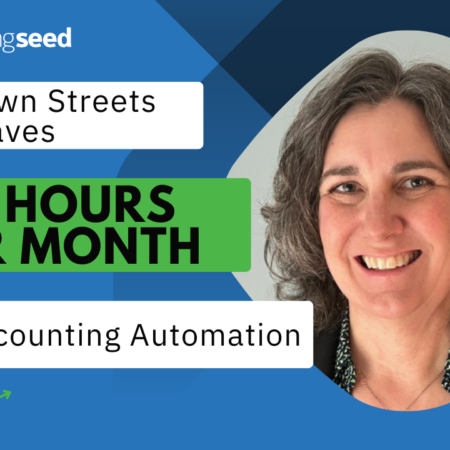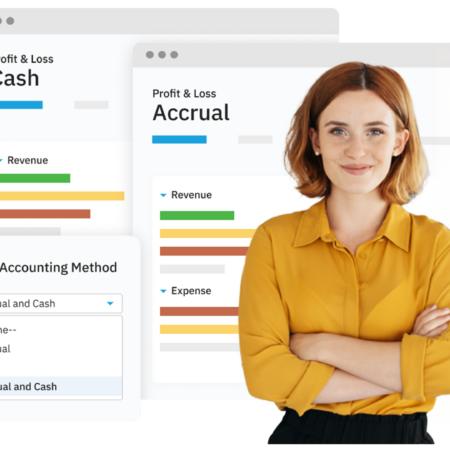
Whether your company is a startup or a superstar, success takes planning, and planning takes knowledge. But—when you have clients to meet and staff to supervise—it can be tough to know how your company is performing. Are sales on the rise? Are you borrowing too much? Spending too much time on the wrong clients? And how do you know if your answers are correct?
Financial reporting helps you know for sure. The heart of reporting lies in your company’s financial statements, which are incredible tools for analysis and planning. However, putting these reports together can feel intimidating. Just tracking expenses and sales revenue for the income statement is a major number-crunching task.
The good news is that with a modern, cloud-based accounting system, anyone can find the time for in-depth financial reporting. Automated accounting systems make it easy to generate insight-driving reports from the mass of information in your ledgers. Read on to learn why financial reports matter, how to make financial reports, and how the right software package can help.
What Is Financial Reporting?
Financial reporting uses financial statements to show the state of your company’s health to stakeholders Key statements are the balance sheet, cash-flow and income statements, and the statement of retained earnings, with standardized formats so anyone can read and understand them.
1. The Benefits of Better Reporting
If your company is publicly traded, your financial reporting is covered by Securities and Exchange Commission (SEC) regulations. You need a CPA to prepare your statements, and they have to conform to Generally Accepted Accounting Principles (GAAP). Private companies aren’t covered by those regulations, but improving your financial reporting game is still a win.
Drawing up financial statements helps you monitor current revenue and expenses and see how they’ve changed over time. The statements can help you answer multiple questions important to your business’ survival, such as whether expenses are rising faster than revenue.
Accurate financial reporting in a manual system takes a lot of work, you can save a lot of time and frustration with automation software. One reason companies rely on cloud-based, automated accounting software is that it lets businesses generate up-to-the-minute, real-time reports without heavy demands on the staff.
2. Do You Need Financial Reporting?
When business is thriving, it’s often easy to lose track of the big picture. Sales revenue is good, you’re meeting payroll, and you’re paying the interest on your debts. Isn’t that good enough?
No, it’s not; not if you want to plan for future success. Planning requires knowing the answers to key questions, like:
- Is revenue greater than expenses?
- How have revenue streams been trending over the past year?
- How does net income compare to budget projections?
- If your biggest customer neglected to pay their bill, do you have enough cash available to survive?
- Can you afford to take on more debt?
Answering these questions leads to more questions. If, say, your income is growing but cash on hand is shrinking, you need to find out whether that’s from excess spending, late-paying customers, or some other problem. Once you know, you can solve the problem. That’s why financial reporting matters.
Financial Statements: The Big Four
The three most important types of financial reports are the income statement, balance sheet, and cash-flow statement. The statement of retained earnings isn’t as useful for your business planning, but it will be of great interest to your investors.
Each of the four statements offers a different perspective on your company and its finances. Combined, they provide a big-picture view that can improve your planning and strategy. They’re also important when dealing with people outside the company. Lenders and investors rely on financial reporting to tell them if putting money into your business is a smart move.
Regulators such as the Securities and Exchange Commission may review your financial reporting to confirm you’re complying with GAAP rules. Customers who want to develop a long-term relationship with you as a vendor may also review your statements to gain insight you might be around for the long haul.
1. The Balance Sheet
The balance sheet is a simple equation: total assets = your liabilities + the owners’ equity. If you do your calculations correctly, the two sides always balance.
That simple equation requires a lot of financial reporting. Your assets include everything the company owns, such as cash, equipment, real estate, vehicles, computers, furniture, land, and intellectual property. Your liabilities include every unpaid debt at the time you drew up the statement: utility bills, vendor invoices, taxes, outstanding loans, and payroll expenses.
Equity is what’s left when you subtract debts from assets. If you have $3.5 million in assets and $2.5 million in liabilities, that leaves $1 million in owners’ equity. If you closed your doors tomorrow, that $1 million is what the investors would divide after you paid off your creditors.
2. Income Statement
The income statement shows your revenue, your expenses, and what’s left when you subtract one from the other. At the top of this report, you report your sales revenue for the quarter or the year. You subtract expenses such as the cost of goods sold, labor, advertising, depreciation, taxes, and so on. What’s left at the bottom is your net income, positive or negative, for the accounting period in question.
3. Cash-Flow Statement
You don’t need an income statement if you run your accounting on a cash basis. If you use accrual accounting, you need both an income and a cash-flow statement. The difference between them is that the cash-flow statement doesn’t record transactions until money changes hands.
Say you complete a $5,000 project on the last day of the quarter. That $5,000 goes on the income statement for the quarter, but not on the cash-flow statement. Cash flow doesn’t recognize the $5,000 until the client pays you. In accrual accounting, you need both statements to create a clear financial picture.
The financial reporting in the cash-flow statement tracks cash from operating activities, investment activities, and financing activities. It subtracts cash expenses from the total to determine how much cash you have on hand.
4. Statement of Retained Earnings
Suppose your profits for the first year are $437,000. So, you issue $137,000 as a dividend to your investors but retain the remaining $300,000. That amount equals your retained earnings. Next year, if you retain more profits, your total retained earnings will go up. The statement of retained earnings tracks the total.
Your profitability and the size of any dividends you issue will affect your earnings. So will time. If you’re a new business, you may hang onto your profits to invest in future growth. If you’re an established company, you may be able to issue larger dividends to keep your investors happy.
The Uses of Financial Reporting
Financial reporting collects multiple individual transactions—computer repair bills, gas for the company truck, the 100 sales you made yesterday—and translates them into a usable format. This creates perspective for anyone who reads the reports. Maybe sales were slow this week and expenses were high, but looking at the quarterly income statement, you can see you’re doing well and the bad week was a fluke.
If your business needs a cash infusion, your financial statements are an essential tool. Showing a bank or a venture capitalist that you have excellent cash flow and growing income proves you’re a good investment. Investors may be interested in how high your expenses are, and may ask pointed questions about which ones you’re willing to cut.
Potential investors will also want to see the statement of retained earnings. Based on the age and profitability of your company, among other factors, they’ll decide whether you’re holding on to too much money to be a good investment.
1. Using The Income Statement
The net income figure on the income statement tells you how profitable the quarter was—or wasn’t. It also shows how much your operating expenses are. If you list the line items as a percentage of the total, you can get a sense of where most of your money goes.
Comparing the figures in the statement to your budget projections, you can see how close you came and figure out where your projections went wrong. Looking at several quarters or years of income statements lets you zero in on trends. Is revenue growing or shrinking over time? Have costs stayed constant? Are there annual patterns you can anticipate, such as high seasonal sales?
Using the income statement as a budget-tracking tool like this is one of the most important financial reporting tips for businesses to master.
2. Using The Cash Flow Statement
While the income statement shows how profitable you are, the cash-flow statement shows how much money you have. The two are not the same. If you have lots of sales income but none of your clients have paid, those sales won’t help you make payroll or pay the power bill. A profitable company with poor cash flow can end up in trouble.
As with the income statement, studying the cash-flow statement can generate further questions. Which activities generate the most cash? Where do you spend most of your cash? If cash flow is poor, what’s the reason—a rush of one-time repairs or a long-term systemic problem?
Answering those questions helps with your planning. Once you know where most of your cash comes from, you can prioritize those activities or try increasing cash generation from other areas. If bad cash flow results from a systemic problem, you know it needs to be fixed.
3. Using the Balance Sheet
The financial reporting on the balance sheet gives you a snapshot of what you own, what you owe, and what your company is worth. You can use this information to answer several questions: Do you have enough assets to pay your debts? Are there assets you could sell off for extra cash? Is your level of borrowing too high?
The answers will depend partly on what kind of industry you’re in and whether you’re running a new, established, or aging business.
How Automated Cloud Accounting Software Helps
Creating financial reports manually, even if they’re only for you and your management team, takes time and effort. Depending on your skill with figures, financial reporting can become an exercise in frustration. The solution, saving you time and effort, is to use accounting software to automate your financial reporting process.
Accounting Seed’s cloud-based, automated accounting software can generate a standardized financial report for small businesses with the click of a button, incorporating your most up-to-date information. It can also create customized reports to compare income and cash flow to budget projections, or to analyze historical trends.
Accounting Seed is native to the Salesforce Platform, intuitive to use, and easy to customize for the needs of your particular business. If you need to show financial reports for a last-minute venture-capital presentation, it’s much easier to do it with an accounting software package like Accounting Seed.
To see for yourself how easy and intuitive your accounting system can be, contact Accounting Seed today and ask for a demonstration. Your financial reporting process will quickly transform from a hassle to a business-driving comfort.
About Accounting Seed
With over 50,000 users globally, Accounting Seed utilizes the Force.com Platform to seamlessly connect data from sales lead to accounting ledger—providing a complete view of business performance in one system without costly integrations. Want expert advice on the benefits of accounting natively on Salesforce? Let’s talk.
See Accounting Seed in action
Get a close-up view of how accounting on Salesforce can eliminate the need for costly integrations—and silos of mismatched information—by sharing the same database as your CRM.



